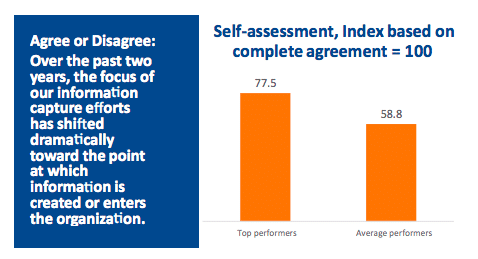
Information Governance Pressure Points – 3 Common Areas of Failure
Information Governance | Automation
Back in the day, when work was centralized in locations and on devices “within” the enterprise, it was reasonable to assume that control could most effectively be maintained by managing security at the firewall. Information security was largely a function of “keeping the bad guys out.”
Fast forward to today’s business environment, and it’s a much different story. We’re all doing some portion of our work remotely, using mobile and cloud technology to do it. Meanwhile, the bad guys have become even more advanced.
This new business environment has led to governance failures at three key pressure points:
- Information “entry points”
- Information “end points”
- Policy administration
Let’s explore what's causing the pressure at each of the three points.
Governance Pressure Point 1 - Information “Entry Points”
We have more entry points for information to come into our business environment than ever. Organizations that have adapted their information management strategies to the cloud and mobile need to extend their governance strategies as well. For many, the governance strategy for new entry points is an afterthought instead of an upfront consideration.
- Key Stat on Information “entry points”
- "As the first generations of scanning and capture solutions are retired, organizations have the ability to adapt their capture strategies to the challenges created by Digital Transformation. In this process of modernization, capture capabilities must: a) become smarter; and b) move to the point at which information first comes into the organization. Top Performing organizations are driving toward the objective of Intelligent Capture by pushing information capture closer and closer to the point of information creation while also maintaining advantages of scale." - 4 Strategies to Conquer Information Chaos with Intelligent Capture.
Governance Pressure Point 2 - Information “End Points”
Information end points like PCs, smartphones, and IoT devices are another point of pressure for information governance. Organizations are unable to access data on endpoints, automatically find and categorize private and sensitive data, leverage and grow historical data intelligence, validate past categorizations, and integrate effectively with off-premise cloud-based repositories. They also usually manage information after it comes into the organization rather than as it enters.
- Key Stats on Information “end points”
- Only 40% have automated processes to ensure the deletion of personal information.
- 62% of organizations have essentially given up on the ROT problem, relegating it to manual approaches or simply keeping everything.
- Information chaos needs to be tackled at its origins — 85% see failure to digitize and standardize (and automate!) business inputs as a key Transformation bottleneck.
Governance Pressure Point 3 - Policy Administration
On top of these two IG pain points also sits policy administration. Most policies tied to information governance are managed manually. In a world of manual processes, even keeping these policies up to date is problematic. Trying to demonstrate compliance in this manual environment becomes next to impossible.
- Key Stat on Policy Administration
- Simply keeping up with governance, risk, and compliance changes is a huge challenge for 33%, followed closely by managing all of the information that proves compliance (24%).
The Solution: Automate the Governance Process
We are gathering information at unprecedented scale — this isn’t new. What is new is that for the first time we have tools to make sense of it.
The massive growth in information creates significant risks for organizations. But, it also creates opportunity for new value and experiences for both internal and external customers.
If you can free yourself from the mundane tasks associated with information governance, there is tremendous opportunity to fully utilize and optimize information assets.
The opportunity begins by embracing AI and machine technologies that allow organizations to automate the process of information governance. Without these technologies, organizations are at risk of drowning in a sea of information chaos. With them, organizations can shift their focus to enhancing customer experiences.
Here’s How to Get Started Automating Your Information Governance Strategy
If you're just getting started, don't feel discouraged.
Our research shows that for 70% of organizations, key governance processes are less than 50% automated.
Plus, you don’t have to go down this automation journey alone. Your friends here at AIIM can help. Check out this FREE Webinar On Demand, and learn how to strengthen your information governance practices by streamlining and automating. AIIM’s President, Peggy Winton and Iron Mountain’s Steven E. Lester and Kelly Matoney cover:
- Current privacy regulations
- Data breaches and other risks of governance gaps
- Creating policies that work
- Reaping the benefits of automated information governance




